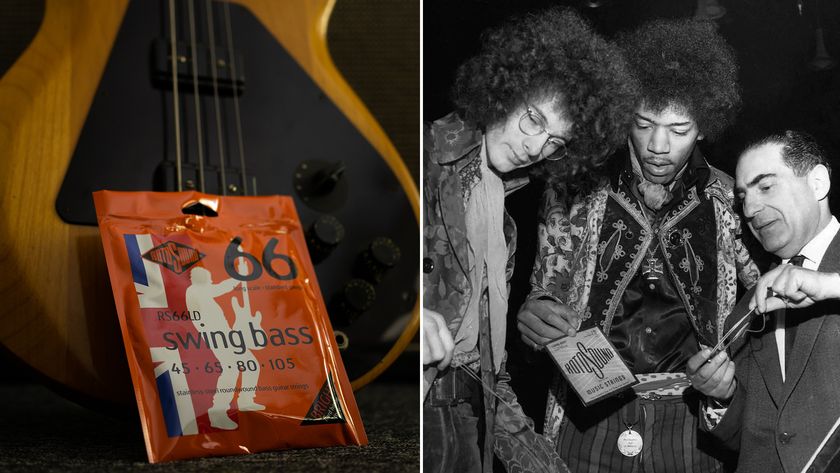In Deep with Andy Aledort: Transposing Open-G-Tuned Slide Licks to Open D Tuning

Over the past two columns, we covered many of the common chord forms and licks used when playing slide guitar in open G tuning (low to high, D G D G B D).
In addition to open G, one of the most commonly used open tunings for slide is open D, tuned, low to high, D A D Fs A D. Open E, another very popular slide tuning, is structured, or voiced, the same as open D, except all strings are tuned one whole step higher (low to high, E B E Gs B E), so all the scale and arpeggio shapes are the same.
Derek Trucks is that rare example of a guitarist who plays everything in open E, whether he is using a slide or not. The Duane Allman favored open E for almost all of his slide work, the lone exceptions being “Dreams” and “Mountain Jam,” for which he played slide in standard tuning, which was the tuning he used for all his non-slide playing.
If you have gone through all of the examples illustrated in these past two In Deep columns, you should have a strong grasp of how the licks in an open G tuning “fall” on the fretboard. Now we will transpose those licks to open D tuning.
Figure 1 illustrates a standard “open-G-style” lick. In bar 1, the first note is a high G root note, sounded on the first string’s fifth fret, followed by F, the flat seven, at the third fret, then D, the fifth, on the open string. I then slide down to C, the fourth, on the second string’s first fret, and slide up to F#, the major third, sounded at the fourth fret on the third string, followed by the open G root note on the third string. In this tuning, G root notes are found at the fifth fret on the first string, on the open third and fifths strings, and at the fifth fret on the fourth and sixth strings.
When we switch to the open D tuning described above, all of the root notes, D in this case, are found one string lower. Likewise, all of the licks and phrases fall on the board in the same way as they do in open G tuning but are located one string lower. Figure 2 illustrates the structure of open D tuning. When retuning from open G to open D, the sixth, fourth and first strings remain tuned to D, the second string goes down one whole step, from B to A, the third string is tuned down one half step, from G to F#, and the fifth string goes up one whole step, from G to A.
Let’s now take the lick shown in open G tuning in Figure 1 and transpose it to open D by moving all of the notes one string lower, as shown in Figure 3. I begin with a high D root note sounded at the fifth fret on the second string, and then work my way down through the pattern to the D root note one octave lower on the open fourth string. This lick culminates with the open sixth-string low D, followed by the D root one octave higher on the fifth string’s fifth fret.
Get The Pick Newsletter
All the latest guitar news, interviews, lessons, reviews, deals and more, direct to your inbox!
It will take a little time to get acclimated to this new open tuning. This, of course, will be true whether you are familiar with open G or if this is the first time you’ve ever tried playing in any type of non-standard tuning. Keep in mind that the principal benefit of using open tunings, whether for slide or standard fretting, is that full or partial chords are sounded very easily by simply strumming across several strings at any given fret, lending a rich sonority to the sound of the instrument that is not attainable in standard tuning.
Also, remember that when playing slide, most players pick the strings with either their bare fingertips, with a combination of a thumbpick and fingers, with a thumbpick and fingerpicks, or with a flatpick and the bare fingers, which is known as hybrid picking. I prefer to play slide with my bare fingers, bringing the flatpick into play occasionally for greater volume and attack on specific notes within a melodic phrase.
When I first got into slide guitar, my primary influence was Johnny Winter, in particular his playing on his first two albums, Johnny Winter and Second Winter. Slide masterpieces from his first record include “I’m Yours and I’m Hers” and “Dallas,” and Second Winter features “I Love Everybody” and the tour de force “Highway 61 Revisited,” which Johnny plays in an open D tuning.
Figures 4, 5 and 6 offer a variety of phrases played in open D tuning and in Johnny’s style. Figure 5 illuminates the influence of Muddy Waters, especially in the use of phrases played on the first string. Figure 6 offers a long workout in the tuning, so do your best to memorize these licks and phrases in order to attain a firm grasp of slide soloing in this tuning.
One of the true giants of slide guitar is the late, great Earl Hooker, who played primarily in standard tuning. One of the coolest things about Earl’s style is that he would effortlessly move back and forth between slide and non-slide licks and standard fretting, a technique expanded upon by the Rolling Stones’ Mick Taylor. Figure 7 is played in Hooker’s style, with constant alternating between slide “solo”-style licks and melodies and standard fretting used for more conventional rhythm guitar–type accompaniment.
Guitar World Associate Editor Andy Aledort is recognized worldwide for his vast contributions to guitar instruction, via his many best-selling instructional DVDs, transcription books and online lessons. Andy is a regular contributor to Guitar World and Truefire, and has toured with Dickey Betts of the Allman Brothers, as well as participating in several Jimi Hendrix Tribute Tours.













